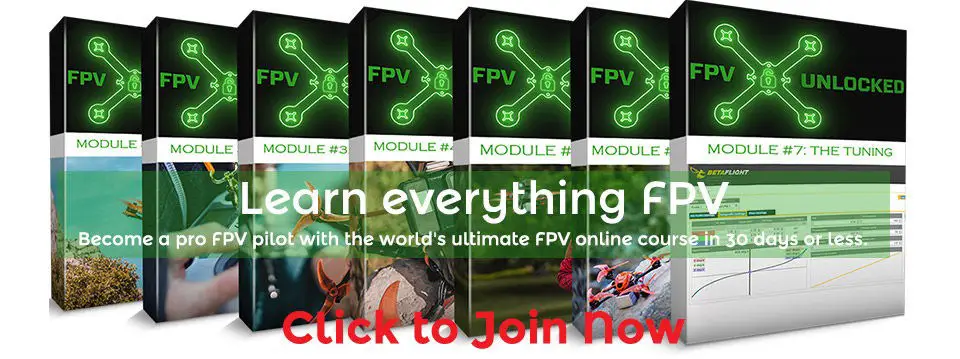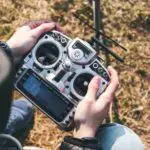If you are planning to buy a drone, you probably come across the word FPV drone. So, what are FPV drones, and how does it differ from conventional drones? I believe I have an answer for you.
Technically, FPV drones are drones that stream video feed in-flight using a video transmitter, so that pilots can fly the drone from the first person view perspective. Sometimes, this term is applied only to highly agile FPV drones used for racing or performing freestyle tricks.
Let’s dive in a little deeper on what makes FPV drones unique, things that you can do with FPV drones, and how much does it cost to buy one.
- FPV Drones vs “Normal” Drones
- Presence of Video Transmitter on FPV Drones
- Different Pilots’ Vision Perspectives
- Use of Headless Mode in Normal Drones
- FPV Drones Have Powerful Motors
- FPV Drones Can Perform Aerial Tricks
- Normal Drones can Hold Position or Altitude
- Normal Drones have A Better Camera
- Normal Drones Fly Longer
- FPV Drones Can Fly Beyond Line of Sight
- Table of Comparison for FPV and Normal Drones
- What can I Do with FPV Drones?
- Can I Convert any Drones into FPV Drones?
- What Do I Need to Fly an FPV Drone?
- How Expensive are FPV Drones?
FPV Drones vs “Normal” Drones
Presence of Video Transmitter on FPV Drones
In a broader term, FPV drones are differentiated from the normal drones by the presence of a camera and a video transmitter (VTX) on the FPV drone.
As its name implies, VTX transmits video captured through the camera onto a screen (be it monitor or FPV goggles) so that the pilot can see the real time video feed.
Nowadays, camera and video transmission become a standard for most drones. So, while those 2 components are essential for FPV drones, they are not the key differentiator.
Different Pilots’ Vision Perspectives
FPV means first person view. In FPV drones, the pilots see through the camera mounted on the drone instead of looking at the drone from a third person view.
While many camera drones can stream live video to a mobile phone, FPV hobbyists do not classify them as FPV drones.
This is because pilots of camera drones often maneuver the drone while visually looking at the drone itself and the video feed, instead of relying solely on the video feed. As a result, they are seeing a third person view, instead of a first person view or FPV.
In contrast, FPV pilots rely solely on the video feed provided by the camera on the drone, as well as data from various sensors to maneuver the drone. They fly the drone as if they are sitting inside the drone, viewing from the cockpit.
Use of Headless Mode in Normal Drones

Another crucial differentiator of FPV drones is the flight mode. When you are flying an FPV drone, your direction is always aligned with the drone’s. The drone’s front will always be your front (as if you are in the cockpit), regardless of how it is orientated from you.
Normal drones usually fly using headless mode. In headless mode, the drone will register its orientation when you arm it. As it flies, the drone will change its “head” to make sure it aligns with your “front”.
FPV Drones Have Powerful Motors
To truly enjoy the immersive FPV and perform aerial tricks, FPV drones are designed to be powerful and agile.
There are always exceptions though. Some people like to cruise with FPV drones. So, powerful motors are not important for them.
Normal camera drones are just not powerful or agile enough to produce similar movement like what FPV drones do. Hence, the FPV drones are often associated with racing drones or freestyle drones.
FPV Drones Can Perform Aerial Tricks
FPV drones do not auto level, although they can. Without auto level, and coupled with the powerful motors, FPV drones can make crazy movements otherwise constrained by auto-leveling. The tricks you can do with an FPV drone are limited to your imagination and the laws of physics.
In contrast, normal drones are auto-leveled, which means the drone will auto correct its position when you are not controlling it. On top of that, the pitch and roll of the drone are limited to a certain angle so it doesn’t flip. Some normal drones are programmed to flip and return to level with 1 button.
Here’s a video of tricks that can be done by FPV drones, but not normal drones.
Normal Drones can Hold Position or Altitude
Nowadays, almost all normal drones can hold position and altitude. You can literally release the controller, and the drone will stay where it is. This is useful for many people, especially when you need time to make decisions, or want to take clear photos.
In contrast, most FPV drones can’t hold position and altitude. You can, however, add in some sensors, and use specific firmware to make your FPV drone hold position and altitude (refer to Github for the exact firmware and sensor).
Normal Drones have A Better Camera
You may think FPV drones have better camera quality than normal drones since FPV pilots rely heavily on the video feed to make sense of the surrounding environment. That’s not true though.
FPV drones are designed to be fast and agile. There is simply limited space or weight allowance for a big, high quality camera. That’s why a lot of FPV pilots put up a GoPro on their FPV drones to capture higher quality videos.
Moreover, the quality of wireless streamed videos is affected by various factors. I’d say the bottleneck is the video transmission from the drone to your FPV goggles. It doesn’t make sense to have a high quality camera if the video cannot be effectively transmitted to the display.
Things are changing though. With the advancement of digital FPV technology, there will be better cameras for FPV drones.

Normal Drones Fly Longer
Due to the aggressive flying style, the battery in FPV drones typically lasts only for a few minutes.
In contrast, normal drones usually fly slower, and use high capacity Li-Ion batteries. Hence, they can fly longer.
FPV Drones Can Fly Beyond Line of Sight
With FPV drones, you can fly it as far as you want to (within legal boundaries) for as long as you are still receiving the video feed. However, you can only control a normal drone if it is within your line of sight.
Table of Comparison for FPV and Normal Drones
Here’s a table of comparison between conventional FPV drones and normal drones.
| Features | FPV Drone | Normal Drone |
|---|---|---|
| Video Transmitter | Yes | Maybe |
| Pilot’s perspective | First person view | Third person view |
| Headless mode | Irrelevant | Yes |
| Auto-leveling | Optional | Yes |
| Able to perform aerial tricks | Yes | No |
| Hold position/altitude | Usually no | Yes |
| Motor | Very powerful | Weak |
| Camera quality | Lower end | Higher end |
| Flight time | Usually short | Medium to long |
| Flying beyond line of sight | Yes | No |
What can I Do with FPV Drones?
You can fly FPV drones for competitive racing, or enjoy it as a hobby with freestyle tricks or long range cruising. You can also do cinematography using cinematic FPV drones.
Can I Convert any Drones into FPV Drones?
Technically, you can convert any drones into an FPV drone by adding a camera and a video transmitter. But realistically, that involves a big overhaul because the existing components on your device may not support the addition of a camera or VTX.
Since every component of the drone is interrelated (read more on how drones work), you may need to change most of the components to ensure compatibility. It might be easier to just build one from scratch, or buy a pre-built drone.
What Do I Need to Fly an FPV Drone?
To fly an FPV drone, you need the drone, a radio transmitter, FPV goggles, and battery packs for the drone. They are usually sold separately. You also need to buy a charger that charges LiPo batteries, and a parallel charging board if you want to charge multiple LiPo simultaneously.
How Expensive are FPV Drones?
A reliable entry-level FPV drone costs around $250. That includes everything you need to fly the drone. Higher end FPV drones can cost more than $400 for the drone only. There is no maximum price because hobbyists tend to upgrade to better parts as they progress in the hobby.
There are cheaper FPV drones offering more features and extended flight time, which cost below $70. While they are technically called FPV drones, they lack the key features that FPV drones have. For example, they don’t have powerful motors, and they have auto leveling that holds them back from performing aerial tricks.
Other than the initial investment on the drone, there could be other costs, such as license fees and spare parts. If you are residing in the US, you can find out the cost of indulging in the FPV hobby here.


